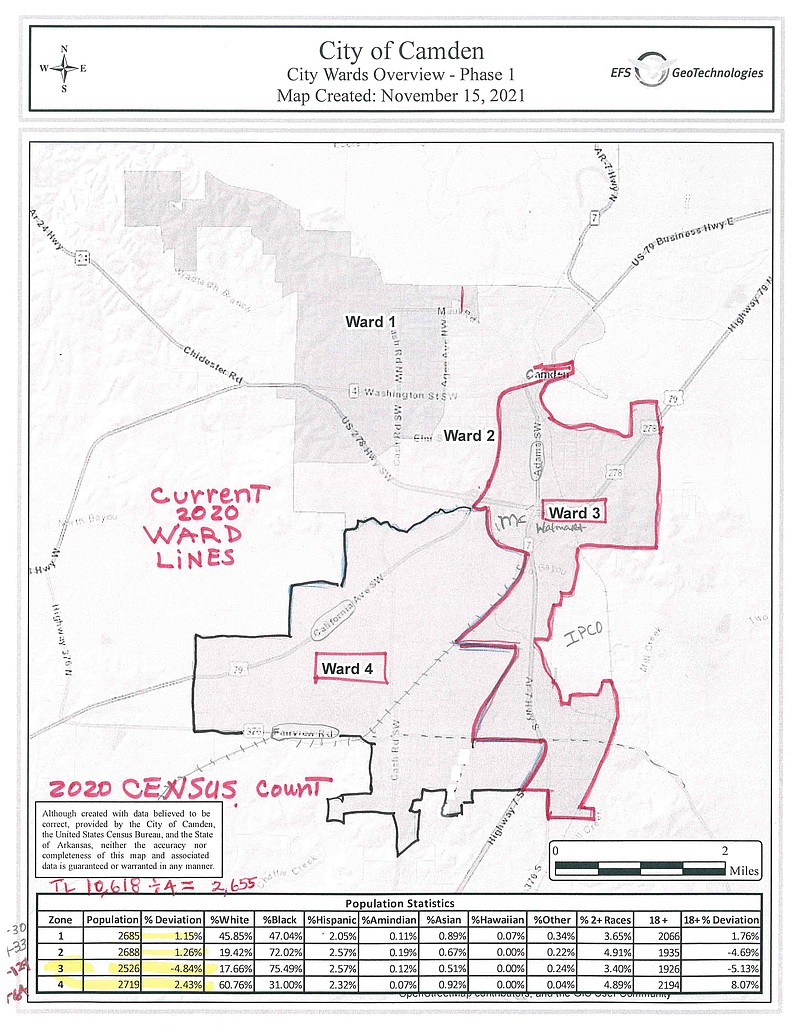The City of Camden Board of Aldermen will vote on redistricting city wards at their next regular meeting scheduled for April 12.
Ordinance No 2-22. would modify "the boundaries for the election of aldermen" and approve "the redistricting of city wards."
The Ordinance has had two prior readings, but has been tabled as the aldermen did not favor the proposed map submitted by the mayor.
As of the 2020 Census the population breakdown in the wards as they're currently drawn were:
- Ward 1: Population 2,685 - 45.85% white; 47.04% black; 2.04% Hispanic
Ward 1's deviation from the total population is 1.15%.
- Ward 2: Population 2,688 - 19.42% white; 72.02% black; 2.75% Hispanic
Ward 2's deviation from the total population is 1.26%.
- Ward 3: Population 2,526 - 17.66% white; 75.49% black; 2.57% Hispanic
Ward 3's deviation is -4.84%. The negative number signifies Ward 3 having less population than the other wards.
- Ward 4: Population 2,719 - 60.76% white; 31% black; 2.32% Hispanic
Ward 4's deviation is 2.43%.
City Attorney Michael Frey explained that the deviation percentages reference how far away the actual population of each city ward is from what the population of each ward would be if they were equal.
"For instance, if each ward had 3,000 people in at the redistricting, then there would have been 0% deviation. But of course, people move in and out of wards, and the population within in each ward changes," Frey said.
Mayor Julian Lott proposed two options for redistricting and Alderman L.E. Lindsey submitted one option, but no redrawn map has been settled on yet.
"According to the 2020 census, our total population was 10,618. If each ward has 2,655, there would be 0% deviation," Frey explained, adding, "It would be extremely difficult to draw wards with an exactly equal number. And in any event, the 2020 census was a snapshot at that moment. So even if the proposal was drawn for an exactly equal population of 2,655, that would only have been true back in 2020. The actual population and addresses would have already shifted in reality."
Because of that, a deviation of less than 10% is considered reasonable, Frey said.
"The goal is to be sure that each ward has the same number of people, so that it is 'one person; one vote.'" he said.
Frey also noted that the population of each ward isn't necessarily reflective of the number of voters within a ward.
"Interestingly, all of this is somewhat academic and slightly out of focus. The census population of 10,618 is the TOTAL population, not registered voters. So it includes children, unregistered voters, unqualified voters," he said in an email. "But we assume for practical purposes that each ward has the same percentage of children, unregistered voters, as any other ward. But we're always going to be off by a small amount."

